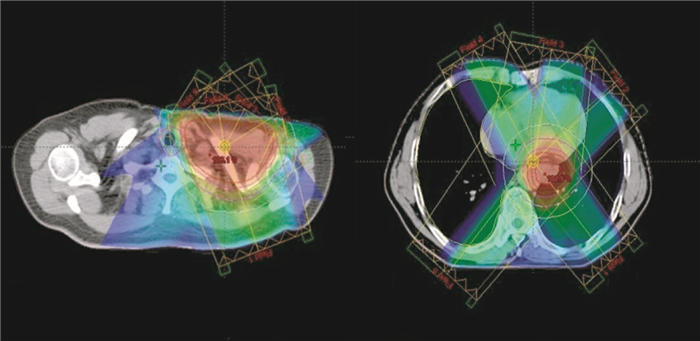-
近年来,IMRT质量保证的新型剂量验证工具——二维矩阵探测器[1],能够实现对照射野中感兴趣点剂量(绝对测量)和平面剂量(相对剂量)的测量,并与治疗计划系统计算出的剂量相比较,由于数据的采集和分析全部由计算机控制,所以操作误差较小且验证效率较高。学者Van Esch等[2]和Syamkumar等[3]曾用二维矩阵探测器进行实际机架角IMRT质量控制剂量验证,另有学者Poppe等[4]和Hussein等[5]进行过0°机架角的剂量验证,均取得了良好的效果。然而,目前对实际机架角和0°机架角两种剂量验证方法比较的研究报道较少。因此,本研究首先对二维矩阵探测器Detector729剂量测量校准,然后进行实际机架角和0°机架角IMRT治疗计划剂量验证,并对两种剂量验证结果进行比较,以期为IMRT治疗计划的准确实施提供可靠的保障。
HTML
-
采用美国Varian 23EX医用电子直线加速器(6MV档位的X射线,剂量率为300 cGy/min,机头内置60对多叶准直器)及Pinnacle 8.0 m三维治疗计划系统; γ射线由中国疾病控制中心辐射安全所国家二级标准剂量学实验室的60Co远距离治疗机产生; 采用由中国计量院刻度过的德国PTW放疗剂量仪及TW30013 0.6 cm3电离室进行剂量测量和校准工作,并将电离室选作参考电离室; 使用美国GE Discovery 16排双螺旋CT仪采集影像资料(扫描层厚2.5 mm); 采用不同厚度、30 cm×30 cm的密度为1.045 g/cm3的RW3固体水作为剂量学模体。
验证系统由德国PTW OCAVIUS Detector729二维电离室矩阵、八角模体及分析软件组成:矩阵平板重约3.2 kg,有效测量面积为27 cm×27 cm,包含了相邻间距为10 mm、灵敏体积为0.125 cm3的729个柱形空气电离室,剂量率的测量范围为0.1~10 Gy/min,剂量测量重复性为0.2%~1%,在2~500 cGy的剂量范围内线性良好。
-
随机选择在中国人民解放军军事医学科学院附属医院放疗科就诊的13例经病理证实的头颈部、体部肿瘤患者,且均为首程放疗。所有患者或其家属均于检查前签署了知情同意书。用Pinnacle 8.0m治疗计划系统进行直接子野优化算法制定IMRT治疗计划。
-
将Detector729的中心电离室放置在60Co远距离治疗机射野20 cm×20 cm的中心,源皮距为80 cm,将温度、气压值输入到Verisoft软件中,设定测量时间为60 s,测量6次; 6 h后,再以同样的方式测量6次。
在6 MV X射线、源皮距为100 cm、射野为10 cm×10 cm、出束100 cGy的条件下,将二维电离室矩阵面板放在5.0 cm厚的固体水上面,使中心电离室有效测量中心点放置在固体水下5.0 cm射野中心轴上,测量5次; 在同样条件下将0.6 cm3参考电离室测量5次。根据两种剂量计的测量结果完成对矩阵电离室的剂量测量校准。
-
对13例患者进行治疗体位定位CT扫描,扫描图像经网络传输到治疗计划系统,放疗物理师根据图像做出IMRT治疗计划(图 1)。将患者的治疗计划转移到Detector729及八角模体的CT扫描图上,保留所有的计划参数不变,做出两种验证计划:一种是实际机架角照射治疗计划,一种是所有机架角归一到0°的治疗计划(图 2),并重新分别计算Detector729有效测量点所在面的剂量,得到两种验证计划的平面剂量分布。将每例患者的两个治疗计划移植到加速器治疗系统中,对Detector729及八角模体进行照射,用分析软件Verisoft采集矩阵有效测量平面的剂量分布,从而得到两种验证剂量与计划剂量的符合程度。
-
对二维矩阵探测器及配套软件测量剂量分布与IMRT计划系统算出的剂量分布进行比较,目前应用较广的是γ分析方法[6]。Low和Dempsey[7]将γ分析方法与剂量偏差(dose difference,DD)和位置偏差(distance to agreement,DTA,也叫等剂量距离偏差)组成复合判断标准,较科学地得到IMRT计划和实际测量差异的量化值,γ验证通过率随着判断标准数据的增加而升高。计算γ值的公式如下:
其中:
$ r\left(r_{m}, r_{c}\right)=\left|r_{c}-r_{m}\right| ; \delta\left(r_{m}, r_{c}\right)=D_{c}\left(r_{c}\right)-D_{m}\left(r_{m}\right);\;\Gamma\left(r_{m}, r_{c}\right)=\sqrt{\frac{r^{2}\left(r_{m}, r_{c}\right)}{\Delta d_{m}^{2}}+\frac{\delta^{2}\left(r_{m}, r_{c}\right)}{\Delta D_{m}^{2}}} $ 式中: rm为测量点的位置; rc为计算相对点的空间位置; Δdm为设定位置偏差距离; ΔDm为设定剂量误差; Dc(rc)为在rc处计算的剂量; Dm(rm)为在rm处测量的剂量。
美国医学物理学家协会的报告[8]和部分学者[9]推荐使用DD 3%(DTA 3 mm)或DD 4%(DTA 4 mm)作为判定标准,本试验测量时选择了DD 3%(DTA 3 mm)、DD 3%(DTA 4 mm)和DD 4%(DTA 4 mm) 3种DD和DTA作为判定标准,分别得到了γ验证通过率。验证通过的标准是:验证点的γ≤1时,验证点通过。如果平面剂量验证所有点的通过率>90%,说明验证计划通过,可以实施治疗。
-
用统计学软件SAS 9.3对数据进行分析。首先检验3种DD和DTA的γ验证通过率是否符合正态性,然后用成组t检验分析各种验证通过率差异是否具有统计学意义,P<0.05为差异有统计学意义。
1.1. 实验材料
1.2. 临床资料
1.3. Detector729的剂量测量重复性及校准
1.4. IMRT剂量验证
1.5. Gamma(γ)分析方法
1.6. 统计学分析
-
Detector729在60Co γ射线下两次测量重复性均<0.3%,表示测量结果具有良好的一致性。矩阵中心电离室和参考电离室在同样的条件下测量的平均值分别是880.1 mGy和863.6 mGy,计算出参考电离室对中心电离室的校准因子为0.981,将此系数输入到二维矩阵探测器的测量软件系统中,则其测量值即为校准过的吸收剂量。
-
从3种DD和DTA的验证通过率来看,两种剂量验证方法通过率大部分在90 %以上,总体来说实际机架角计划验证通过率均较0°机架角计划验证通过率低。实际机架角IMRT验证计划的3%(3 mm)、3%(4 mm)和4%(4 mm)的平均通过率分别为91.2%、92.4%和95.6%,较0°机架角计划的3%(3 mm)、3%(4 mm)和4%(4 mm)的通过率分别低了2.2%(t=-2.04,P=0.053)、2.2%(t= -2.02,P=0.055)和1.4%(t=-1.97,P=0.060),两种剂量验证通过率相比较差异无统计学意义(表 1)。
患者序号 3%(3 mm) 3%(4 mm) 4%(4 mm) 实际机架角 0毅机架角 实际机架角 0毅机架角 实际机架角 0毅机架角 1 91.5 93.4 93.5 94.8 98.3 97.0 2 91.9 92.6 97.0 95.0 98.0 99.0 3 86.3 90.2 86.3 99.1 94.5 99.1 4 85.4 95.4 90.9 96.9 91.4 98.5 5 97.2 93.0 97.0 94.0 98.0 95.8 6 91.6 93.3 93.2 94.7 97.6 99.2 7 85.0 92.5 86.9 95.8 92.2 97.2 8 91.7 93.4 92.3 92.3 96.1 96.2 9 93.3 94.5 93.8 94.1 95.6 95.7 10 94.6 95.2 92.8 93.2 94.8 95.0 11 93.2 95.0 94.1 94.3 95.1 96.2 12 92.6 93.8 93.5 93.8 95.2 95.4 13 90.8 91.4 90.4 91.2 95.4 96.4 平均值 91.2 93.4 92.4 94.6 95.6 97.0 t值 -2.04 -2.02 -1.97 P值 0.053 0.055 0.060 Table 1. Gamma passing rate of different dose difference and distance to agreement between unfixed-gantry and fixed-gantry verification methods
(%)
2.1. 测量重复性及刻度
2.2. IMRT剂量验证
-
剂量测量重复性是放疗剂量计的一个重要剂量学特性指标,表示测量结果的一致性、可信度。Detector729电离室在短期内剂量测量重复性<0.3%,与相关研究结果基本一致[3, 10],满足IEC60731-2011《医用电气设备:电离室剂量计检定规范》[11]对测量剂量仪重复性的要求。为了保证不同电离室测量结果的准确和统一,厂家采用60Co γ射线统一对729个电离室进行了校准,校准因子以文件的形式储存在分析软件中,在剂量测量过程中将会自动调用。为了保证量值测量的准确性,在相应的射线质下对矩阵进行剂量测量校准非常必要。
本研究采用Detector729及其配套八角模体进行实际机架角验证和0°机架角计划验证,结果显示两种方法的通过率基本上都在90%以上,实际照射剂量验证和0°机架角剂量验证均与验证计划剂量分布基本一致,说明二维矩阵探测器适合应用于IMRT剂量验证工作。IMRT治疗计划复杂,在照射野中剂量梯度变化大,国外学者研究发现使用方野照射,在不同角度照射与垂直照射的通过率有所不同[12]。本研究选取的13例治疗计划由于治疗部位和子野合成野的不同而导致在同一判定标准下的验证通过率并不相同。在不同的判定标准下,各组的通过率数据符合正态性,对0°验证计划与实际验证计划的通过率进行统计学分析,结果发现各组通过率的差异无统计学意义,因此不能认为两种剂量验证方法的通过率有所不同。实际机架角剂量验证能够考虑到治疗照射的多角度性、加速器自身剂量学特性及多叶准直器受重力影响而导致DD[13]等因素,因此,实际机架角剂量验证结果更加符合放疗的真实情况。
综上所述,Detector729测量结果可信,可以应用到IMRT质量控制剂量验证工作中,鉴于目前对IMRT质量控制剂量验证具有严格的要求,建议医疗机构选择实际机架角进行剂量验证; 分析两种剂量验证方法,确保治疗计划的准确实施,对促进我国放射治疗质量保证和质量控制工作的广泛开展具有重要意义。











 DownLoad:
DownLoad:
